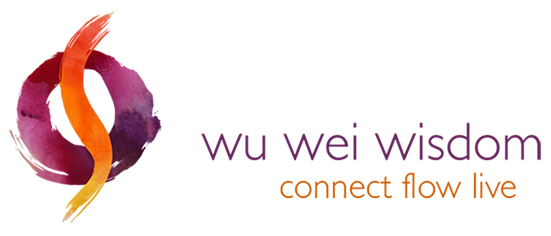introduction to qigong energy healing (3/3)
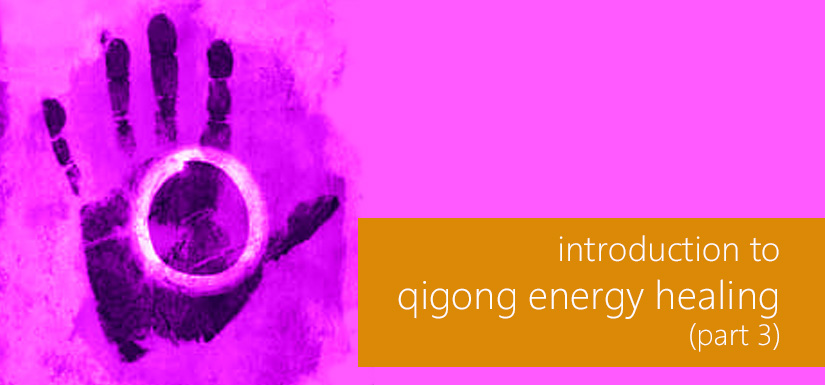
summary
This is the third part in a series of articles on sharing my understanding and experience of Qigong healing, also known as ‘Medical Qigong’, one of the lesser-known areas of traditional Chinese medicine.
In this final article in the Qigong healing series I explore ways of approaching Qigong healing practice and outline some basic healing protocols that may help you as you embark on your wonderful journey as a healer.
full teaching transcript
Working with the ‘Helpers’
As I have mentioned before, one of the challenges I face when writing about Qigong healing is articulating the profound teaching of the Tao, the Universal experiences and the personal emotional connections that underlie this practice, which quite simply go beyond words.
One of the reasons I decided to share my experiences and knowledge of Qigong healing was to reassure you that the insight and guidance to unlock your healing potential are always there when you need them, whether they come in the form of articles such as this, a trusted teacher, Universal synchronicity, your intuition or just an old fashioned ‘gut feeling’ – your ability to heal is there within you, ready and waiting!
The most important thing is for you to be connected to your own Qi and never doubt yourself or what seems authentically correct for you. Even when the opinion of others may be contrary to your thinking or your Ego mind causes you to question your healing ability or the techniques you use, always follow your authentic path of self-worth and potential.
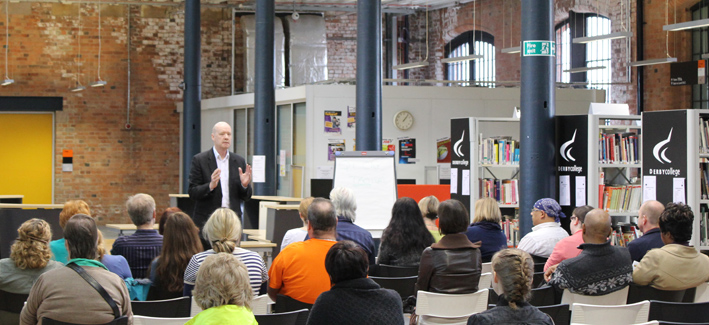
Guidance can be found in both the Tao Te Ching and I Ching, which teach through metaphor, visualisation and analogy in order to explain the concept of healing.
These texts can be extremely helpful in shedding new light on what may otherwise seem complex, or personal situations connected to your healing ability and practice, but sometimes may also be confusing, especially if you have not yet fully experienced or appreciated healing energy sensations for yourself, if you do not have a trusted teacher or guide to help you on your spiritual path, or if you are ‘stuck’ in an emotionally out-of-balance place that may be difficult to recognise and which will affect your healing journey.
The key is to always be prepared to expand your reading and knowledge from a non-judgemental position. For example, several chapters of the I Ching mention the concept of Qigong healing and the concept of Universal or cosmic wellbeing under the term of ‘helpers’ or ‘Universal helpers’ which, in keeping with the Taoist principle of Macro-Micro, encompasses both your inner knowing and healing abilities and the Universal flow of healing energy – you and the Universe are one and the same.
I personally like the term ‘helpers’ and find it less emotive than other descriptions I have encountered in China such as ‘entities’, ‘deities’, ‘spirits’,and even good or bad ‘demons’ or ‘dragons’, or indeed the terms ‘angels’, ‘guardian spirits’ or ‘devils’ that are commonly used in the West.
To me the term ‘helpers’ conjures up an image of healing or harmonious Qi working to subtly rebalance energy blockages at the micro level whilst embracing the macro concept of Universal help and healing that does not conform to the (as yet) known laws of physics or medicine. Thus, with an open heart and mind, we may accept that the impossible is possible and can expect the unexpected!
In this regard I think selected media stories relating near death experiences, ‘miraculous’ recoveries and spontaneous remissions can be very helpful and allow us to question what many people consider to be the scientifically established ‘truth’ and the restrictions that this places on human potential. (I greatly appreciate the work of Dr Bruce Lipton and I would encourage you to read his recent book ‘Spontaneous Evolution’ and consider his conclusions on this fascinating subject.)
The I Ching teaches us that our Universal helpers work through a process of gently melting, dissolving and transforming of energy blockages, and I like to use the visualisation of a glacier slowly turning from ice to water – sometimes slowly melting, sometimes large shards breaking off, but always as a result of subtle natural forces.
The healing process does not involve excessive power, force, effort, control, contriving, doubt or resistance: if your thinking is engaged in this way, the practice becomes counter-productive as the Ego mind-set of self-protection and isolation takes over, disconnecting you from your Universal helpers and blocking the flow of healing Qi.
Remember, Qigong healing is not a human-centred practice: when you practice healing, you are attempting to align yourself with the Universal Qi or Spirit, so it is important to think and act like the energy you are seeking to transmit and align with. Remember you came from the source, you will return to the source; therefore you are the source.
Opening protocol
There are no set rules or regulations concerning the protocol of Qigong healing other than it is vital that you take time to connect to your Qi, move out of any human-centred thoughts that you may have, and hand over to the Universe.
This is why I recommended in my previous healing article that you should take time at the beginning of the practice to first meditate and check you are feeling relaxed, open-minded and centred in your Wu Wei; remind yourself that you already know every Universal truth, that the Universe is a healing place and that you are at one with this energy flow.
The following is a simple and effective way to approach your healing practice that I teach new students at my private clinic and personal development centre, Peak House Practice, before moving onto more advanced and intuitive methods of healing.
Begin the healing practice by asking your client to sit on a chair and then gently rest your hands on their shoulders. Bring your body into a relaxed and comfortable position with your feet approximately shoulder-width apart, knees slightly bent, coccyx tucked in, shoulders relaxed, head floating on the shoulders – this position is known as Wu Ji.
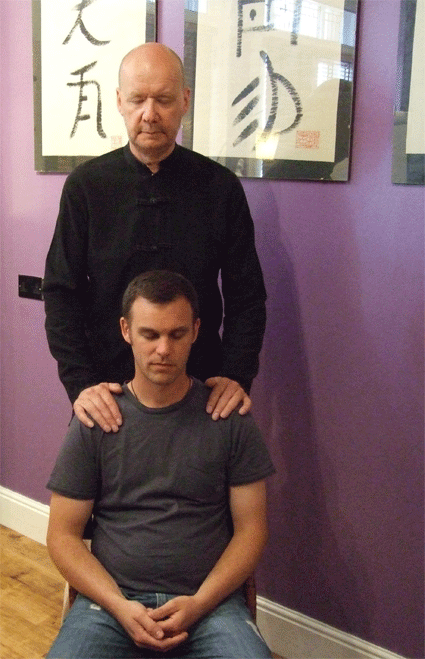
Then imagine a ‘centreline’ travelling down from the highest point in your head (Bai Hui), passing behind your eyes, nose, mouth, down through the centre of your throat and chest, and out of the perineum and landing between your feet.
Use this centreline to help you with your physical balance, check that your head is floating on your shoulders, your shoulders feel balanced and level, the hips are relaxed, and that there is no physical tension in your body.
Then use this centreline visualisation to guide your breathing: imagine a pair of bellows deep in your abdomen that open and close as your breath gets drawn down the centreline of your body.
Never rush this opening protocol: if you notice doubt creeping in, discreetly take a moment to refresh your mind and your thoughts, return back to your centre and begin the process again. If this happens you will notice that rarely do you have to do the ‘reset’ more than three times before the Ego quietens and you return to your authentic WuWei.
After a while you will notice that your hands start to feel lighter and your body and mind goes into a deeper, more profound meditation.
Be happy to follow this process, trust and allow the ‘helpers’ to take over and, as you do this, you will notice your hands begin to move without your conscious effort. Although this can feel a little disarming at first, just try and follow the Qi.
Allow the ‘helpers’ to move your hands around your client’s head and body without restriction, thought or diagnosis – just be part the process!
Trusting the Qi
Every healing treatment will feel unique and so it should, given that the energy dynamic between you and your client is a particular reflection of that moment in time. This is why it is extremely important never to judge or have any preconceived ideas of a client’s healing needs, their ‘illnesses’ or the location of areas of energetic blockage and stagnation.
For example, someone may report trouble with headaches or migraines but the ‘helpers’ may direct you towards their neck, shoulders or chest – remember they will always direct you to the energetic root of the problem and the associated block or stagnation rather than focusing on the presenting manifestation or symptoms.
Physical pain can be very similar to a red light on the dashboard of a car – it gives us a warning of problems that may lie elsewhere!
You may also find your hands are drawn to and follow the Traditional Chinese Medicine meridians or channels around the body and, if this happens, simply follow the Qi – you don’t need knowledge of acupuncture or Chinese medicine to do this; just relax in an open, inquisitive and sympathetic way and enjoy the process.
Try not to question yourself, the position of your hands or the direction in which you’re being led. Sometimes you will find that your hands feel as if they need to ‘hover’ over a point or area of the head or body; again just allow this to happen.
As a general rule you will be drawn towards a blockage or stagnation that your client may or may not be aware of, and part of the healing process is to help them move this block, whether it be physical, mental or emotional.
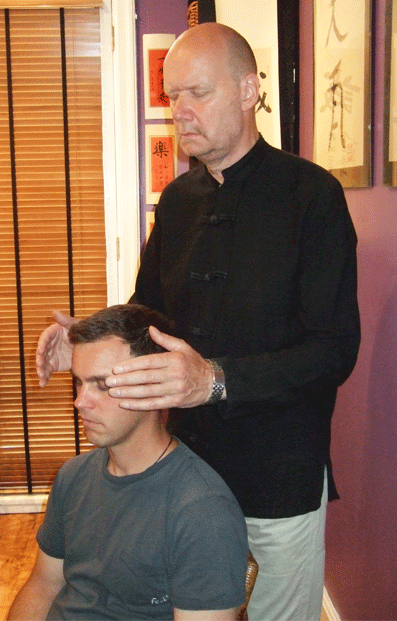
Remember also not to overthink, direct or command the ‘helpers’; if you do so, you will disconnect from the Qi. This can happen in the early part of your practice and if it does, just slowly return your hands back to your client’s shoulders and go through the opening protocol of clearing your mind and centring your breath again.
Remember that the ‘helpers’ have no limitations, they are not restricted to our perceptions of time or space: this is why longstanding illnesses or blockages can sometimes be transformed or moved within seconds and why we do not have to be in close physical proximity to a client for them to receive our healing intentions.
Sometimes the work is done on such a profound harmonious level, it is beyond human understanding, so rather than overly interrogate the process, trust that the work is completed when your intuition tells you it is so.
Many people ask me about the relationship and similarities on Qigong healing and Reiki healing, which is a more well-known and popular form of energetic healing in the West. Although many of the fundamentals are the same, I would say that Qigong healing differs from Reiki mainly in its application.
When healing under the discipline of Reiki, the practitioner usually follows a set of preordained hand positions, sometimes even following set times of leaving the hands on the patient; by contrast Qigong healing is much a more intuitive process, whereby you allow yourself to follow or to be led by the Qi, trusting your ‘helpers’ to draw your attention areas where healing is required.
Healing and the Tan T’ien
A special mention is needed for the three main areas of energy within the body that the Chinese refer to as the Tan T’ien, which are very similar to what is known in yoga practice as the chakras. These energy centres are located on the centre-line that passes through the core of the body (and not on the surface of the skin) and it is thought that core energies spiral outwards in all directions from these points.
The first Tan T’ien, (Yin Tang) commonly referred to as the ‘Third Eye’, is situated between the eyebrows crossing the centre-line in the middle of the head; the second (Tan Zhong) is in the centre of the chest, again crossing the centre-line in the middle of the torso and the third (Qi Hai) is approximately three inches below the navel crossing the centre-line in the middle of the abdomen.
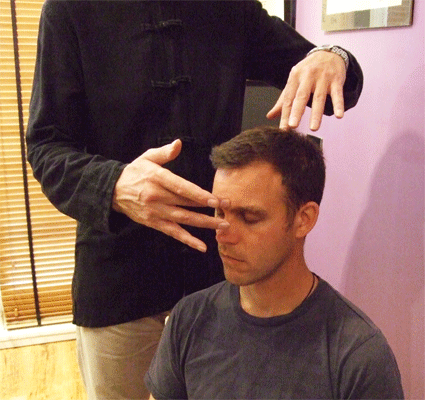
I have discussed the Tan T’ien and Qigong meditation practice elsewhere on my blog (read article here), and in a healing situation with a client, you may also find yourself connected to these physical areas and drawn to access them from the top, front or rear of your client’s body.
For instance, you may find one hand is drawn towards the front of the chest aligning with the Middle Tan T’ien and that your other hand is drawn to a similar point on the centreline along your client’s back.
Sometimes your hands will be drawn close to the point within your client’s body and other times it may feel appropriate to hold and rest your hands some distance from the Tan T’ien; just follow your hands and the Qi. This process is quite normal and it usually signifies a general tonification of energy is required in that area of the body.
Closing protocol
You will know instinctively and intuitively when it is time to bring the healing session to an end. When this happens, allow your hands to return to your client’s shoulders; never pull away quickly, give yourself time to disengage – this may take up to five minutes before you to return to your centre-line, checking your breathing, finding your balance.
When you think the process has come to its natural end, step backwards with your left foot, then the right foot, joining them together. Make a light fist with your left hand and cup your right hand over it, make a slight bowing movement of respect and say “Thank you” quietly to yourself and the Universe.
Conclusions
I hope this article series has provided you with a sound philosophical and practical base from which to explore your healing practice and that you will enjoy the experience of healing as part of your personal spiritual journey as much as I do.
I am mindful that it is impossible to cover such a profoundly broad area of Traditional Chinese Medicine and energetic practice in the space of three short articles, but I hope that it has whetted your appetite and that the simple act of reading my words may have already had a transforming effect on your Qi field.
If it is a practice that interests you, then trust your intuition to point the way and always remember that you are not alone or without help in the Universe.
~ Yi Tao, Qi Tao ~
Where Your Intention Goes, Energy Flows
This series of articles on Qigong healing is also published in the International IMOS Journal.
want more support
Discover how David can help you rebalance your health and wellbeing with his one-to-one sessions.
You can also:
- join our free Wu Wei Wisdom Facebook Group where you’ll find lots more guidance and discussion
- sign up for our free weekly email newsletter with all our latest teachings and news.
If you have any questions or would like more information on our work please contact us – we’re always happy to help.
like this post?
Please share it! This helps to pass on the positive Qi of our work to others who may benefit…
